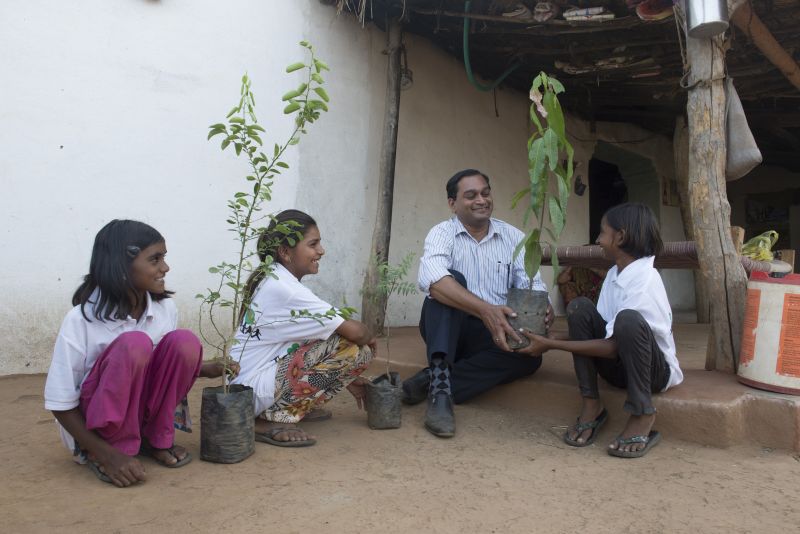
Walking the Green Mile
September 7, 2016
Words by Annila Harris – World Vision India
Part two of a two part series looking at trees in India and a World Vision special climate change project. This is the Annila’s first-hand account of her time visiting the project with technical expert Salmon Jacob

Programmed to sound off a wakeup call, the alarm rings aloud at 04:00 am, jolting all those peacefully entranced in beauty sleep. Racing against the break of dawn, Salmon Jacob, Advisor – Environment (Climate Change), World Vision India, steps out, in the darkness of early morn, to embark upon a day long journey through the blistering hot and semi-arid Baran district of Rajasthan. Utilising the travel time to draft a detailed programme packed with follow-up activities, Salmon draws attention to the urgency for a Climate Change Project in the region.
According to the Forest Survey of India, the forest area in Rajasthan has shrunk considerably.
In 1987, the forest cover (31,151 Sq. Km) was 9.1% of Rajasthan state’s geographical area but within a span of 26 years, the record reports a considerable drop (16,086 Sq. Km) to 4.7% of the geographical area, in 2013.
Passionate about the environment, Salmon grasped the enormity of his calling earlier on in life which ultimately shaped his career path. Devoting himself completely to the cause he acquired in-depth knowledge of the subject by completing his Masters in Environmental Management (MEM) and MPhil in Environmental Science.
“Hailing from the green state of Kerala, where greenery is found in plenty, I was always fascinated by nature. From childhood I have pursued issues of environmental conservation,” says Salmon Jacob, Advisor – Environment (Climate Change), World Vision India.
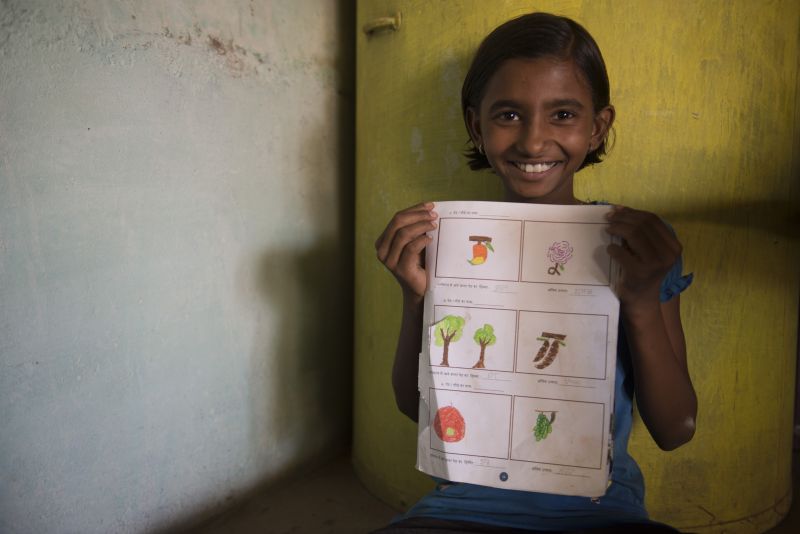
The clock strikes 05:00am, gradually dispelling the gloom of the night, light hits the sky, disseminating vibrant hues of colour across the large expanse. The temperature indicator on the mobile displays in bold, Baran is 36 degrees Celsius at 5am.
“Just imagine if it is 36 degrees Celsius now what would be the temperature at noon,” says Salmon in a concerned tone.
Passing by parched rivers running dry and large spaces of scanty foliage and barrenness, Salmon takes a moment to point out the region’s history deeply associated with forest pocket that was home to a vivacious variety of flora and fauna. But over time the region had lost its green treasures.
Sighting extracts from his conversation with Hajarilal, the former Sarpanch of Khankhara Gram Panchayat, Salmon says,
“The Sarpanch mentioned that this region used to be considered as the Kashmir of Rajasthan with streams of water meandering through the land and greenery found everywhere. Even during peak summer people slept with a shawl, as the nights were cool. Sugar cane filled the landscape of the fields. Water shortage was an alien concept for the villages. The forest teemed with different wildlife like deer, nilgai, wild boar, monkey, sarus crane, vultures and peacocks. But oblivious to the negative effects of deforestation people kept cutting trees for firewood to fuel their traditional stoves. The forests possessing a large composition of teak wood attracted the attention of forest mafia, who hacked the trees down for profit making businesses.
The degradation of the forest has affected the natural environment in many ways, the rainfall has become more erratic and lesser rains compared to earlier times. The degraded forests have significantly reduced the infiltration of rain water and also the water holding capacity of the area. The rain water run-offs have significantly increased, and the water table has fallen significantly in many areas, which in turn propelled farmers to adopt the desperate measure of bore welling to acquire the much needed water for their farmlands. These ecological imbalances are contributing to the issues of global warming & climate change. One of the places in Rajasthan this year (2016) has recorded the highest ever temperature, 51 degree Celsius, in the country. All are evidences of climate change and the repercussions of environmental degradation and forest depletion. It is a herculean task to bring the forests back to somewhat close its original state.”
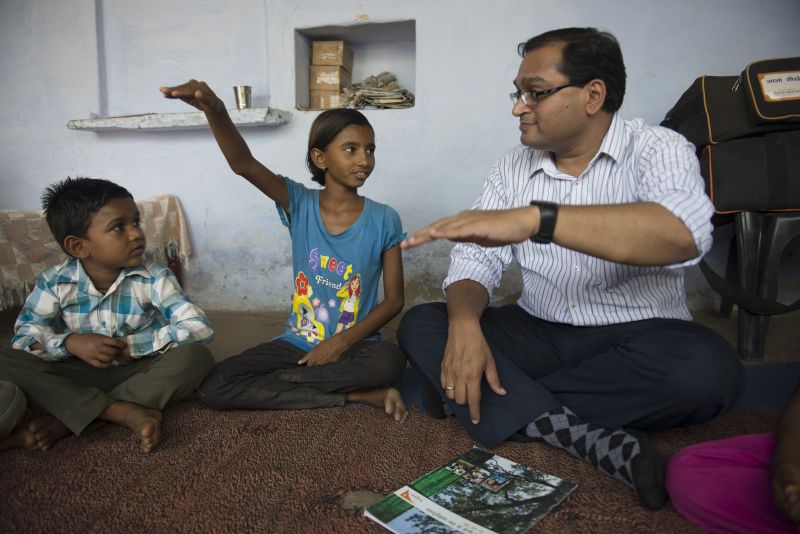
A traditional Rajasthani folk song narrating the desperate longing of a young girl’s heart to, once again, indulge in simple pleasures of the lush green environment present in her maternal home, is an analogy that emotionally depicts the plight of the people in Baran who earnestly yearn for their long lost forest.
The district data available in the Forest Survey of India reports, the percentage of forest area in Baran during 2001 was 16.3% has fallen to 15.5% in 2011. 2011 data states 0 sq. km. of Very Dense Forests (VDF) and 149 sq.km of Moderately Dense Forests (MDF), while in 2001 the dense forest area in Baran accounted for 226 sq. Km.
“In order to make efforts towards tackling the environmental issues, the climate change project was implemented by World Vision India, in Baran district of Rajasthan, which included Indian Chapter for Farmer Managed Natural Regeneration (FMNR), called Community led natural environmental regeneration. The purpose of the climate change project is to promote an environmentally sustainable development approach in the rural context that is low on carbon emissions, and also protects and improves the tree cover of the area. The tree cover is improved by reducing the use of firewood, planting more trees and safeguarding the existing foliage. This requires a multi-pronged approach at the community level. Apart from the special project interventions in Baran, in order to promote FMNR interventions across the country, cluster level workshops were conducted on FMNR in all nine regional zones. The workshops included different people groups like farmers, women, children, and others with the sole intention of engaging everyone in the community. The FMNR programme has now also been included in some of the ongoing technical programmes in drought prone locations, towards building resilient communities,” says Salmon.
Elaborating on the challenges while implementing the programme Salmon mentions that forest degradation particularly in operational areas of Baran had been so severe that fields no longer had any tree stumps left, there were restrictions on the community by forest department to enter the forest area for any pruning activity, plus behavioural changes in the community to put into practice on a day-to day basis would take time. Stopping at the nursery, Salmon gets off to browse through plant saplings. Scanning the yard he selects a few indigenous saplings to present at the children’s club. Giving an explanation for the sapling purchase Salmon says, “Children, being the future of tomorrow, are one of the major focus areas for us because they are among the most vulnerable groups in the community who would be impacted by the issues of climate change. With issues of climate change increasing in the recent future, children born today will definitely be impacted by them. We have to sensitise them about the causes and consequence of environmental degradation and climate change, how it affects their lives and the world around them. Sensitising children transforms them into future guardians of their natural vegetation. World Vision has a sensitisation programme for children which include the basic science of climate change. What are the impacts? How are their own local communities impacted? Through programmes we help them understand the small things they can do to contribute in addressing issues and reducing impact of environmental degradation and climate change.”
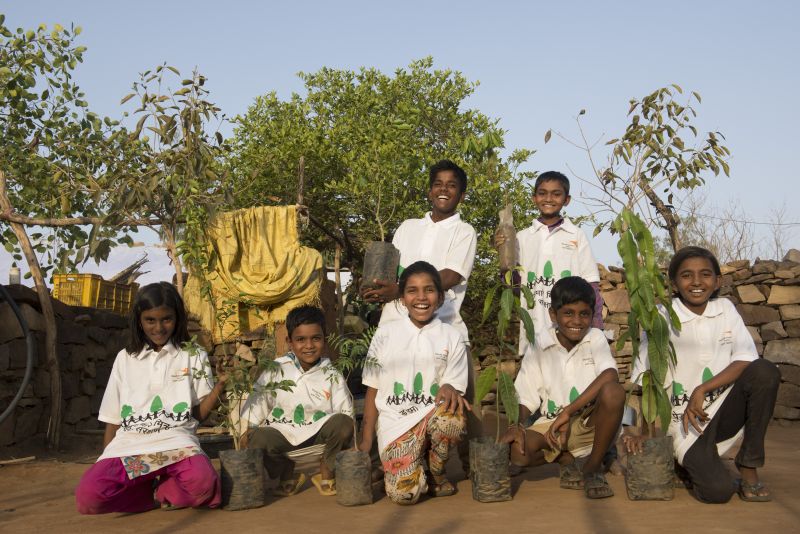
Riding off to the nearby village he stops over to visit 36-year-old Jagdish Suman and his delightful family. Having been given a bio-gas unit by World Vision, the family had shifted from their traditional way of cooking. Welcoming Salmon with open arms Jagdish Suman says,
“Sir please come in. Nice to see you, hope all is well. I shall ask my wife to make a cup of tea and we can talk some more.”
“I am well, thanks. Just wanted to enquire how your bio-gas unit is working,” says Salmon.
“Better than our earlier system, sir. Both firewood and cow dung cakes were hazardous fuel causing pollution and damaging the environment. Cutting trees from the jungle for firewood was a laborious and time consuming process that also destroyed the forests. Starting our traditional stove was tedious because we had to collect the firewood, burn it, and wait for it to set a blaze and then cook. This process had to be repeated every time we needed to cook even to make simple things like tea. During rainy season the wood wouldn’t catch fire because it was wet. Now we can make even small meals at our convenience with just a push of a button. The bio-gas unit produces clean fuel that doesn’t pollute. There is no need for firewood anymore,” says Jagdish Suman.
After indulging in further conversation over a cup of hot milk tea Salmon heads further, in the blistering heat, to 52-year-old farmer, Bhagwan Singh who practises farming using organic fertilizer. Bhagwan Singh’s family had received a vermicompost kit from World Vision along with training on how to make natural fertilizer, using the biogas slurry.
Catching Bhagwan Singh in action on his field, Salmon heads in his direction to have a little chit-chat. Wetting his vermicompost trough, Bhagwan Singh diligently adheres to the training facilitated by World Vision on keeping the compost moist for the earthworm to do their bit of converting bio-gas waste, slurry, into natural fertilizer. Greeting Salmon, he gives a detailed progress report.
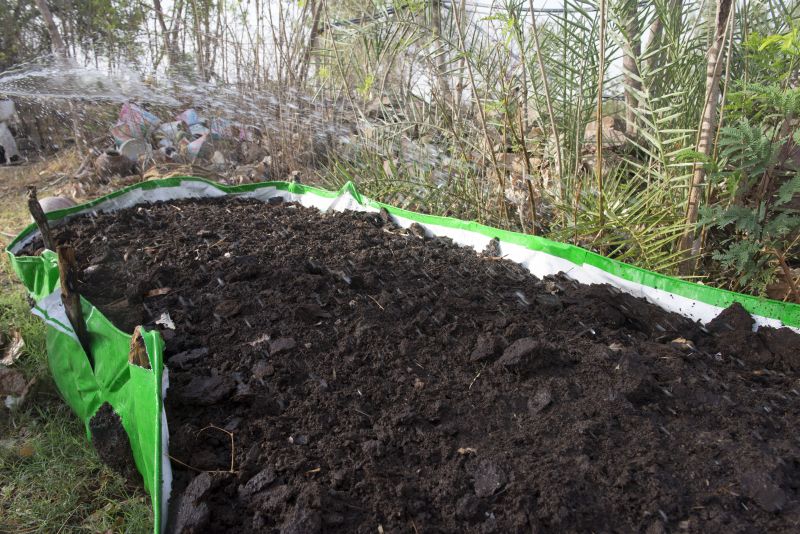
“Slurry, the bio-gas waste, we pile up in the trough. When we have a sufficient amount, the earthworms are let in. I keep the contents moist. Once the earthworms convert slurry into fertiliser, I store them in sacks. In one composting cycle I am able to get 20 bags of 50 kgs each. One bag sells for $13 USD. That becomes an additional income for the household. I also use vermicompost in my field and the results were good. Now, when someone buys vegetables produced in my field they come back for more because they are tasty when cooked. The vegetables grown through vermicompost like cauliflower, ladyfinger, onions and others have helped me gain loyal customers. The yield in terms of quality definitely is much better than when we use chemical fertilisers. It is more tasty and healthy. After vermicompost has come we don’t have to spend a lot on purchasing chemical fertiliser. We save that money. Initially I was sceptical about this process but now once I have tried it, I see it makes a world of a difference in enriching the soil to produce good quality yield,” says Bhagwan Singh with conviction.
Patting Bhagwan’s back, Salmon silently moves to the corner to observe his daily activity.In an attempt to build resilient community programmes, have targeted interventions like renewable energy, climate resilient agriculture, agro-forestry which are instrumental in improving the health of the natural environment. Getting the communities to work on climate friendly and environment friendly livelihood programmes is very essential.As part of the climate change projects in Baran, World Vision has provided 152 families with a bio-gas unit and 105 families with vermicompost kit.
Stepping out of the house Bhagwan’s wife, Sitabai request her husband to suspend his activity and invite the guest for light snacks. Taking this opportunity Salmon enquires about Sitabai’s changed kitchen practices.
“Food cooked in bio-gas fuelled stove is tasty, there is no smoke emission and cooking is no longer a tedious process, it gets done quickly. There is no smoky aftertaste in the food. My kitchen walls don’t have the black soot left behind by the smoke. For a poor person things like this are of great help,” says Sitabai.

Placing the local treats before the gentlemen, Sitabai diverts her attention to caring for her 6-month-old grandchild. Overwhelmed by the warm hospitality of the villagers, Salmon thanks the family and bids his goodbyes.
Navigating through the jagged streets, Salmon reaches a courtyard where children patiently await his presence. Starting a dialogue with the children, in order to sensitise them, he explains the reason why planet earth is unique.
“Having life in our planet makes it unique. There are different forms of life like fish, animals, birds and trees because our planet is special we have to protect it,” he says. Simplifying the global warming talk he uses the analogy of salt which is crucial for food but too much of salt ruins the dish, similarly with carbon dioxide, a little amount is needed but if CO2 increases then it is harmful for the atmosphere. We need more oxygen to breathe which is produced by trees but trees are getting cut,” says Salmon.
Raising her hand 11-year-old Rashmi makes a wise remark.
“If one tree is cut then we have to grow 5 trees to replace them. We have to preserve trees because they give us clean air to breathe and fruit to eat. Because the trees are getting cut there is less rain coming and the earth is getting hotter,” she says.
Eager to add more 12-year-old Saroj says, “We have to take care of trees, give them attention by watering them, putting manure for them. We have to grow more trees.”
Taking a hint from her statement, Salmon asks all those children to raise hands who water their plants. Unanimously all children raise their hands. Encouraging them to further care for the samplings he moves on to check the workbooks given to them in the last workshop. Excited to show their workbooks, Rashmi and Saroj dash to get their work reviewed from Salmon.
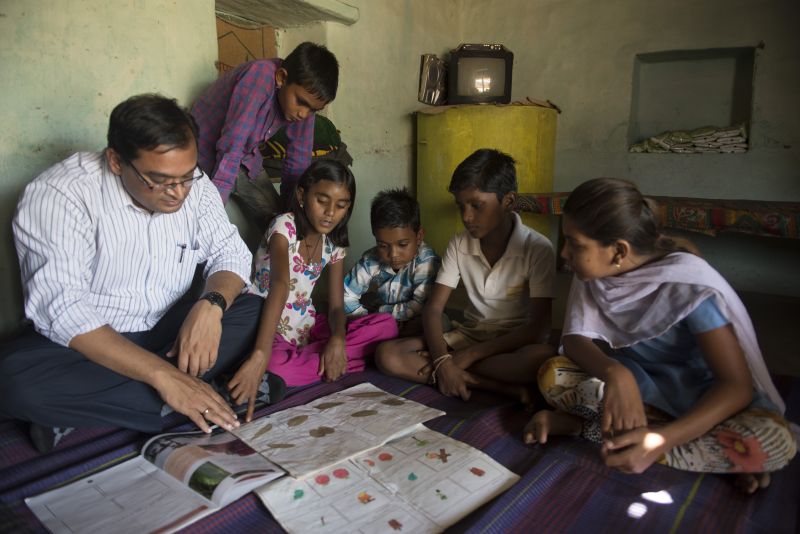
After the sensitisation session, as a reward, along with tree saplings, he presents the children with T-shirts (as part of the project) having environmental message imprinted on them.
“It came to light in my discussion with children especially in areas where there used to be forests 25-30 years back and today there isn’t any that children over the generations had lost the understanding about the importance of having forests and trees, which is a big disconnect. It is very important that we build back these connections. Engaging the children in tree plantation programmes, where tree saplings are distributed and children go through a process of nurturing these plants over a period of three months, that’s the time the plants get roots and gain strength to survive. Children also adopt trees from their immediate surrounding where they live. We have also designed a children’s activity book wherein children are engaged in a process where they learn with fun, they get to know about their immediate environment about the trees and plants in their own village, they get to understand the importance of these trees, their medicinal values and the commercial values, how they add value to the ecosystem, how it enriches the health of the environment in that particular area. This helps children to understand why to protect and conserve the environment,” says Salmon.
World Vision project in Baran has sensitised 1363 children on environmental issues. 7300 saplings were planted by children, youth and community members, through this project in an attempt to improve the tree cover. Apart from the saplings provided by World Vision, the children have also planted saplings on their own and also adopted growing trees from their area to nurture & protect them. It was learnt from the children and the local staff, that 80% to 90% of the tree saplings have survived and most of them have also started bearing fruits.

Travelling for another 2 hours Salmon reaches the last village on his roll call. Joined by 22-year-old Rajender, he does the rounds of the tree garden cultivated by him.
Sharing his life changing decision to nurture plants Rajender says, “My village was lush green once upon a time. It is all gone. The tree saplings, guava and mango, given to me by World Vision inspired me to cultivate my very own tree garden. I chose to plant more trees in the area and even constructed a well within the compound to water the plants. But the true realisation of their importance came to me when I fell sick and craved for shade. I was diagnosed with blood cancer. Each day was a battle that I had to fight. Like, how my family was beside me and supported me through the recovery process, I also realised that trees need someone to protect them and preserve them. I wanted to do that. Having trees in my community is my legacy I want to leave behind. To get better I need to consume fresh produce, which I get from my fruit trees in the garden.”
Confidently answering the question of whether the thought of giving up the task to care for the garden crossed his mind Rajender says, “Plants are like children. In the initial years they need all the attention and care you can give but when they grow up they take care of you. It is like that with trees too. If you care for them now, they will serve you later. Whenever I go for a walk and when I am near trees I can feel the cool breeze coming from them. God saved me so it is my duty to save trees and care for them. I want to see my village green again.”
Presenting his concerns to Salmon, Rajender points out to the pertinent issue of water shortage in their village which hampers the growth of the trees. By adopting painstaking methods Rajender and his family fetch water and carry it a distance to water the garden.
Elated about his first yield Rajender says, “This year we got two and a half quintals of guava from the garden. This was the first time the pomegranate bore fruit. To improve my blood level doctors advised me to eat pomegranate. Now I can eat fresh pomegranates from my farm.”

Completing his field observations, Salmon, after a gruelling long day, rides back. Summarising his visit, he opens up about his aspirations for the project.
“Multiple benefits can be achieved by implementing low cost techniques and my hope is that there will be intentional focus with dedicated staff to drive such projects. If such projects are taken seriously one day issues of farmer suicides and migrations will no longer exist in these drought prone areas. Those farmers struggling today will no longer have to go through the agony of a failed crop and all one would see is smiles on their faces from having a abundant harvest. That’s my ultimate hope,” says Salmon.
